Click on images to enlarge

infestation (Photo: Sheldon Navie)

habit (Photo: Sheldon Navie)

leaves (Photo: Sheldon Navie)

leaf (Photo: Sheldon Navie)

paler leaf underside (Photo: Sheldon Navie)

close-up of stem with ear-shaped structure near the base of a leaf stalk (Photo: Sheldon Navie)

young flower (Photo: Sheldon Navie)
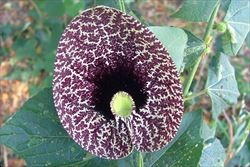
flower (Photo: Sheldon Navie)

immature fruit with short projection at the tip (Photo: Sheldon Navie)

mature fruit (Photo: Sheldon Navie)
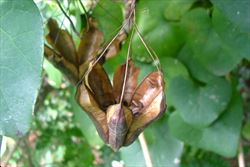
mature fruit releasing its seeds (Photo: Sheldon Navie)
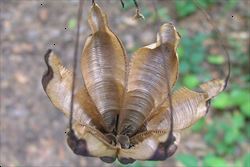
close-up of mature fruit with seeds (Photo: Sheldon Navie)
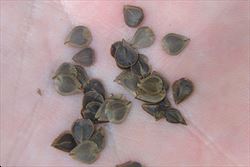
close-up of tear-shaped seeds (Photo: Sheldon Navie)

seedling (Photo: Sheldon Navie)
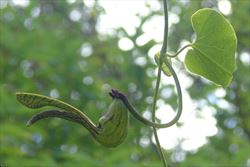
gaping Dutchman's pipe (Aristolochia ringens), with young two-lobed flower (Photo: Sheldon Navie)
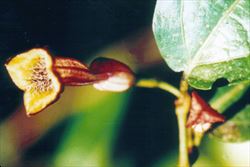
the native Birdwing vine (Pararistolochia praevenosa), which has less spectacular flowers (Photo: Biosecurity Queensland, QDPI&F)
Scientific Name
Aristolochia elegans Mast.
Synonyms
Aristolochia littoralis Parodi
Family
Aristolochiaceae
Common Names
calico flower, calico-flower, Dutchman's pipe, Dutchman's pipe vine, elegant Dutchman's pipe, pipe vine
Origin
Native to South America (i.e. Brazil, Bolivia, Colombia, Ecuador, Paraguay and Argentina).
Cultivation
Dutchman's pipe (Aristolochia elegans) has been widely cultivated as a garden ornamental, particularly in the warmer regions of eastern Australia.
Naturalised Distribution
This species is naturalised in the eastern parts of Australia, where it is relatively widespread. It is common in the coastal districts of southern and central Queensland, scattered in the coastal areas of northern Queensland, and sparingly naturalised in the north-eastern corner of New South Wales (i.e. near Casino). Also naturalised on Christmas Island.
Widely naturalised in the tropical regions of the world (e.g. Zimbabwe, South Africa, Hawaii, French Polynesia, New Caledonia, Fiji, the Cook Islands and south-eastern USA).
Habitat
Primarily a weed of rainforests, closed forests, urban bushland, disturbed sites, roadsides, waste areas, waterways and forest margins in tropical and sub-tropical regions. It is also a potential weed of plantation crops.
Habit
A vigorous climber with stems usually growing up to 3 m long, but occasionally reaching up to 7 m or more in height.
Distinguishing Features
- a climbing plant with slender twining stems and broad heart-shaped leaves.
- there is a small ear-shaped leafy structure at the base of each leaf stalk.
- its unusual tubular flowers (up to 10 cm across) are cream and reddish-purple and have a broad heart-shaped opening.
- its cylindrical capsules (4-6 cm long) have a short projection at their tips and split open from the top when mature.
- these fruit contain numerous tear-shaped seeds.
Stems and Leaves
The twining stems are usually quite slender in nature, greenish in colour and hairless (i.e. glabrous). Older stems may become woody or corky in texture, slightly fissured, and brownish in colour.
The leaves are alternately arranged and borne on stalks (i.e. petioles) 15-50 mm long. At the base of each leaf stalk there is a small leafy structure (i.e. pseudo-stipule) that is ear-shaped (i.e. auriculate). The leaf blades are broad and somewhat heart-shaped (i.e. cordate), kidney-shaped (i.e. reniform) or slightly triangular in appearance (3-10 cm long and 3-12 cm wide). They are hairless (i.e. glabrous) and have entire margins. The upper leaf surfaces are bright green in colour, while the undersides are paler (i.e. discolorous) and slightly glaucous (i.e. bluish-green).
Flowers and Fruit
The showy flowers (about 7.5 cm long and 10 cm across) are borne singly in the leaf forks (i.e. axils) on drooping stalks (i.e. pendulous peduncles) up to 7 cm long. The 'petals' are fused into a bent tube (i.e. actually a perianth tube), that resembles a smoking pipe, with a broad heart-shaped opening. They are pale in colour (i.e. cream or whitish) with numerous reddish or purplish blotches, and have a yellowish throat. Flowering occurs mainly during summer.
The fruit are oblong or cylindrical capsules (4-6 cm long and about 2.5 cm wide) with a short projection (about 10 mm long) at their tips. These capsules turn from green to brown in colour as they mature and become somewhat papery in nature. They split open from the top at maturity to release numerous (about 350) flattened, tear-shaped, brown seeds (about 6 mm long).
Reproduction and Dispersal
This plant reproduces mostly by seeds. These relatively light seeds are usually released from a significant height, hence dispersal is often wind-assisted. Seeds may also be spread by water (if plants are growing along waterways) and in dumped garden waste.
Environmental Impact
Dutchman's pipe (Aristolochia elegans) is regarded as an environmental weed in Queensland and New South Wales, and as a potential environmental weed or "sleeper weed" in many other regions of Australia. It is of most concern in south-eastern Queensland, and it was recently ranked among the top 50 most invasive plants in this region. It is also regarded as a potentially serious environmental weed in north-eastern New South Wales. Like many other species of exotic vines, Dutchman's pipe (Aristolochia elegans) competes with and replaces native plants via its smothering growth. It readily invades dry rainforests, lowland rainforests and riparian vegetation, replacing native vines and preventing the growth and regeneration of other native plants. Community groups are trying to eradicate this plant from several environmentally significant locations in Queensland (e.g. in Burleigh Heads National Park).
However, Dutchman's pipe (Aristolochia elegans) is more well known for its impact on the Richmond birdwing butterfly (Ornithoptera richmondia). This butterfly is listed as a vulnerable species under Queensland legislation and the invasion of remnant habitat by Dutchman's pipe (Aristolochia elegans) is a serious contributing factor to its decline. Birdwing vine (Pararistolochia praevenosa), a similar plant that is native to northern New South Wales and southern Queensland, is the sole food plant of the Richmond birdwing butterfly (Ornithoptera richmondia). This native vine is being replaced by Dutchman's pipe (Aristolochia elegans ) making it hard for the female adult butterflies to find. Because the exotic vine is so similar, the female butterflies are also fooled into laying their eggs on it. However, Dutchman's pipe (Aristolochia elegans ) is toxic to the larvae and when they hatch they are unable to feed and eventually perish. Therefore, removal of this weed is one of the primary strategies of the Richmond Birdwing Recovery Network. The larvae of other native butterflies are also known to perish on Dutchman's pipe (Aristolochia elegans), including the big greasy (Cressida cressida) and the red-bodied swallowtail (Pachlopta polydorus).
Legislation
This species is declared under legislation in the following states and territories:
- Queensland: Class 3 - this species is primarily an environmental weed and a pest control notice may be issued for land that is, or is adjacent to, an environmentally significant area (throughout the entire state). It is also illegal to sell a declared plant or its seed in this state. Note: All non-indigenous species of Aristolochia are also declared in Queensland.
- Western Australia: Prohibited - on the prohibited species list and not permitted entry into the state.
Management
For information on the management of this species see the following resources:
- the Biosecurity Queensland Fact Sheet on this species, which is available online at http://www.dpi.qld.gov.au.
- the information page on Dutchman's pipe vine (Aristolochia elegans) on the Brisbane Rainforest Action and Information Network (BRAIN) website at http://www.brisrain.webcentral.com.au.
- a brief educational film, that discusses the problems caused by this species and methods of control, on the Save Our Waterways Now (SOWN) website at http://www.saveourwaterwaysnow.com.au.
Similar Species
Dutchman's pipe (Aristolochia elegans) is similar to several closely related introduced species that have also become naturalised in Australia, including pelican flower (Aristolochia grandiflora), fragrant Dutchman's pipe (Arsitolochia odoratissima) and gaping Dutchman's pipe (Aristolochia ringens). It is also very similar to the cultivated giant dutchman's pipe (Aristolochia gigantea) which is often confused with pelican flower (Aristolochia grandiflora) in the horticultural industry. These species can be distinguished by the following differences:
- Dutchman's pipe (Aristolochia elegans) has a small ear-like structure (i.e. auriculate pseudo-stipule) at the base of each leaf stalk. Its flowers are relatively large and broad (up to 7.5 cm long and 10 cm wide) and its relatively large fruit (4-6 cm long and about 2.5 cm wide) are oblong in shape with a short projection (about 10 mm long) at the tip.
- giant dutchman's pipe (Aristolochia gigantea ) does not have a small ear-like structure (i.e. auriculate pseudo-stipule) at the base of each leaf stalk. Its flowers are very large and broad (up to 30 cm long and 20 cm wide) and its relatively large fruit (up to 8 cm long and 3 cm wide) are oblong in shape with a very short projection at the tip.
- pelican flower (Aristolochia grandiflora) does not have a small ear-like structure (i.e. auriculate pseudo-stipule) at the base of each leaf stalk. Its flowers are very large (up to 25 cm long) with a very elongated projection at the base of the flower (i.e. appendix) 20-50 cm long. Its very large fruit are oblong in shape (about 10 cm long and 4-6 cm wide).
- fragrant Dutchman's pipe (Arsitolochia odoratissima) has a small ear-like structure (i.e. auriculate pseudo-stipule) at the base of each leaf stalk. Its flowers are relatively large and broad (6-12 cm wide) and its moderately large fruit (4.5-8 cm long and 1-1.5 cm wide) are oblong in shape and slightly curved.
- gaping Dutchman's pipe (Aristolochia ringens) has a small ear-like structure (i.e. auriculate pseudo-stipule) at the base of each leaf stalk. Its flowers are relatively large and narrow (10-25 cm long) and are split into an upper and lower lobe.
There are also several silimar native species (i.e. Aristolochia spp. and Pararistolochia spp.) that might be confused with these introduced species, including the Birdwing vine (Pararistolochia praevenosa). These native species generally have less showy flowers, which are sometimes borne in clusters, and smaller fruit. For example, the Birdwing vine (Pararistolochia praevenosa) has relatively small flowers (up to 20 mm long) that are borne in few flowered clusters while its fruit are oblong in shape (3-4 cm long) and do not have a projection.

